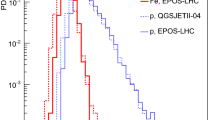Abstract
Using the Auger mass-composition analysis of ultra high energy cosmic rays, based on the shape-fitting of Xmax distributions [1], we demonstrate that mass composition and energy spectra measured by Auger, Telescope Array and HiRes can be brought into good agreement. The shape-fitting analysis of Xmax distributions shows that the measured sum of proton and Helium fractions, for some hadronic-interaction models, can saturate the total flux. Such p + He model, with small admixture of other light nuclei, naturally follows from cosmology with recombination and reheating phases. The most radical assumption of the presented model is the assumed unreliability of the experimental separation of Helium and protons, which allows to consider He/p ratio as a free parameter. The results presented here show that the models with dominant p + He composition explain well the energy spectrum of the dip in the latest (2015–2017) data of Auger and Telescope Array, but have some tension at the highest energies with the expected Greisen–Zatsepin–Kuzmin cutoff. The Auger-Prime upgrade experiment has a great potential to reject or confirm this model.






Similar content being viewed by others
REFERENCES
A. Aab et al. (Auger Collab.), Phys. Rev. D 90, 122006 (2014).
K. Greisen, Phys. Rev. Lett. 16, 48 (1966);
G. T. Zatsepin and V. A. Kuzmin, JETP Lett. 4, 78 (1966).
G. R. Blumenthal, Phys. Rev. D 1, 1596 (1970).
V. Berezinsky, A. Gazizov, and S. Grigorieva, Phys. Rev. D 74, 043005 (2006).
V. Berezinsky, A. Gazizov, and S. Grigorieva, Phys. Lett. B 612, 147 (2005).
R. Aloisio, V. Berezinsky, P. Blasi, A. Gazizov, S. Grigorieva, and B. Hnatyk, Astropart. Phys. 27, 76 (2007).
T. Abu-Zayyad et al., Phys. Rev. Lett. 92, 151101 (2004).
J. Abraham et al., Phys. Rev. Lett. 101, 061101 (2008).
N. M. Gerasimova and I. L. Rozental, Sov. Phys. JETP 14, 350 (1961).
R. Aloisio, V. Berezinsky, and S. Grigorieva, Astropart. Phys. 41, 94 (2013).
A. Aab et al. (Auger Collab.), Phys. Rev. D 90, 122005 (2014).
R. U. Abbasi et al. (TA Collab.), Astropart. Phys. 64, 49 (2015).
T. Abu-Zayyad et al. (HiRes-MIA Collab.), Astrophys. J. 557, 686 (2001).
K. Werner, F. M. Liu, and T. Pirtoj, Phys. Rev. C 74, 044902 (2006).
S. Ostapchenko, Phys. Rev. D 74, 014026 (2006).
D. Garcia-Gamez et al. (Auger Collab.), in Proceedings of the ICRC 2011; arXiv:1107.4807.
R. Conceicao, S. Andringa, L. Cazon, and M. Pimenta (for the Auger Collaboration), EPJ Web Conf. 52, 03004 (2013); arXiv:1301.0507.
L. Collica et al. (Auger Collab.), Eur. Phys. J. Plus 131, 301 (2016); arXiv:1609.02498.
W. D. Apel et al. (KASCADE-Grande Collab.), Phys. Rev. Lett. 107, 171104 (2011).
V. S. Berezinsky, S. V. Bulanov, V. A. Dogiel, V. L. Ginzburg, and V. S. Ptuskin, Astrophysics of Cosmic Rays (North Holland, Amsterdam, 1990).
B. Wundheiler et al. (Auger Collab.), PoS (ICRC2015) 324 (2015); arXiv:1509.03732.
A. Aab et al. (Auger Collab.), arXiv:1604.03637.
R. U. Abbasi et al. (TA Collab.), Astrophys. J. 858, 76 (2018).
A. A. Abdo et al. (Fermi-LAT Collab.), Phys. Rev. Lett. 104, 101101 (2015).
R. Y. Liu, A. M. Taylor, X. Y. Wang, and F. Aharonian, Phys. Rev. D 94, 043008 (2016).
E. Gavish and D. Eichler, Astrophys. J. 822, 56 (2016).
V. Berezinsky, A. Gazizov, and O. Kalashev, Astropart. Phys. 84, 52 (2016).
I. Valino et al. (Auger Collab.), PoS (ICRC2015) 271 (2015); arXiv:1509.03732.
D. Ivanov et al. (TA Collab.), PoS (ICRC2015) 349 (2015).
F. Fenu et al. (Auger Collab.), PoS (ICRC2017) 486 (2017); arXiv:1708.06592.
J. Matthews et al. (TA Collab.), PoS (ICRC2017) 1096 (2017).
V. Verzi et al. (Auger Collab.), in Proceedings of the ICRC 2013, arXiv:1307.5059.
V. Verzi, PoS(ICRC2015) 015 (2016).
R. Aloisio, V. Berezinsky, and P. Blasi, J. Cosmol. Astropart. Phys. 10, 020 (2014).
E. J. Ahn et al., Phys. Rev. D 80, 094003 (2009).
G. Hinshaw et al. (WMAP Collab.), Astrophys. J. Suppl. Ser. 180, 225 (2009).
R. Adam et al. (Planck Collab.), Astron. Astrophys. 596, A108 (2016).
A. Songaila, Astrophys. J. 561, L153 (2001).
R. Y. Liu, A. M. Taylor, X. Y. Wang, and F. A. Aharonian, Phys. Rev. D 94, 043008 (2016); arXiv:1603.03223.
F. W. Stecker, M. M. Malkan, and S. Scully, Astrophys. J. 648, 774 (2006).
P. Younk and M. Risse, Astropart. Phys. 35, 807 (2012).
A. Aab et al. (Auger Collab.), Phys. Lett. B 708, 288 (2016).
A. Aab et al. (for Auger Collab.), Phys. Rev. Lett. 117, 192001 (2016).
R. Takcisin et al., JPS Conf. Proc. 19, 011045 (2018).
S. Ostapchenko, in Proceedings of the 25th European Cosmic Ray Symposia ECRS 2016, arXiv:1612.09461.
Author information
Authors and Affiliations
Corresponding authors
Additional information
The article is published in the original.
Rights and permissions
About this article
Cite this article
Aloisio, R., Berezinsky, V. Towards Solving the Mass-Composition Problem in Ultra High Energy Cosmic Rays. J. Exp. Theor. Phys. 128, 52–63 (2019). https://doi.org/10.1134/S1063776118120014
Received:
Revised:
Accepted:
Published:
Issue Date:
DOI: https://doi.org/10.1134/S1063776118120014




